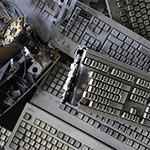
We all know that IT equipment should be recycled and that it is in fact the law that we do so, but many of you might be wondering what actually happens to it afterwards. Here’s a quick peek at what takes place once we take your IT equipment off for recycling.
We have a strict policy that none of the waste we collect goes to landfill sites and IT equipment is no exception. Once we’ve collected your IT equipment we take it to our national distribution centre to be examined by our expert team, who will carefully decide whether it can be reused or whether it needs to be recycled. Wherever possible we try to reuse what is collected, as that’s obviously the best thing for the environment.
Once the equipment has been examined, any that is still in working condition and can be reused will be separated out from the rest, refurbished and distributed across the UK or possibly to some developing nations.
Of course it’s not always possible to reuse equipment, so if that’s the case we will recycle it for raw materials, so that nothing goes to waste.
Anything that can’t be reused will be broken down into its component raw materials, which will then be sent to specialists in the industry for recycling. Absolutely none of the IT waste we receive is buried or burned, so there is nothing going to landfill and no toxic fumes are released – our recycling processes are completely safe and environmentally friendly.
Computer hardware can contain tin, aluminium, iron and silicon as well as various plastics, and all of these can be reused in creating new systems, reducing the costs of manufacture as well as helping the environment. There are also valuable raw materials contained in IT equipment, such as gold, copper and lead to name a few, and all of these can be extracted and reused.
Types of materials in IT Equipment for recycling
Here’s an example of what materials could be contained in your computer and what percentage they each make up, in descending order.
- Ferrous metals are around 32%
- Plastic makes up about 23%
- Non-ferrous metals form approximately 18%
- Glass is about 15%
- Electronic boards make up around 12%
Just one computer can contain up to two kilograms of lead (the old CRTs contained even more explaining why they are so heavy!) . It’s there vital that this is extracted safely and reused and doesn’t end up in landfill. Lead can be extremely harmful to anyone that come into contact with it.
Mobile phones also contain precious metals like platinum, gold and palladium, as well as zinc. Palladium is an important part of the technology used for fuel cells. Zinc is used to galvanise steel or can be used to make brass by mixing it with copper. It is also used by ships and submarines in the form of zinc blocks to prevent rust formation.
This hopefully gives you a better idea of what actually happens to your IT equipment when it is recycled and also highlights how important it is that it is responsibly dealt with.
